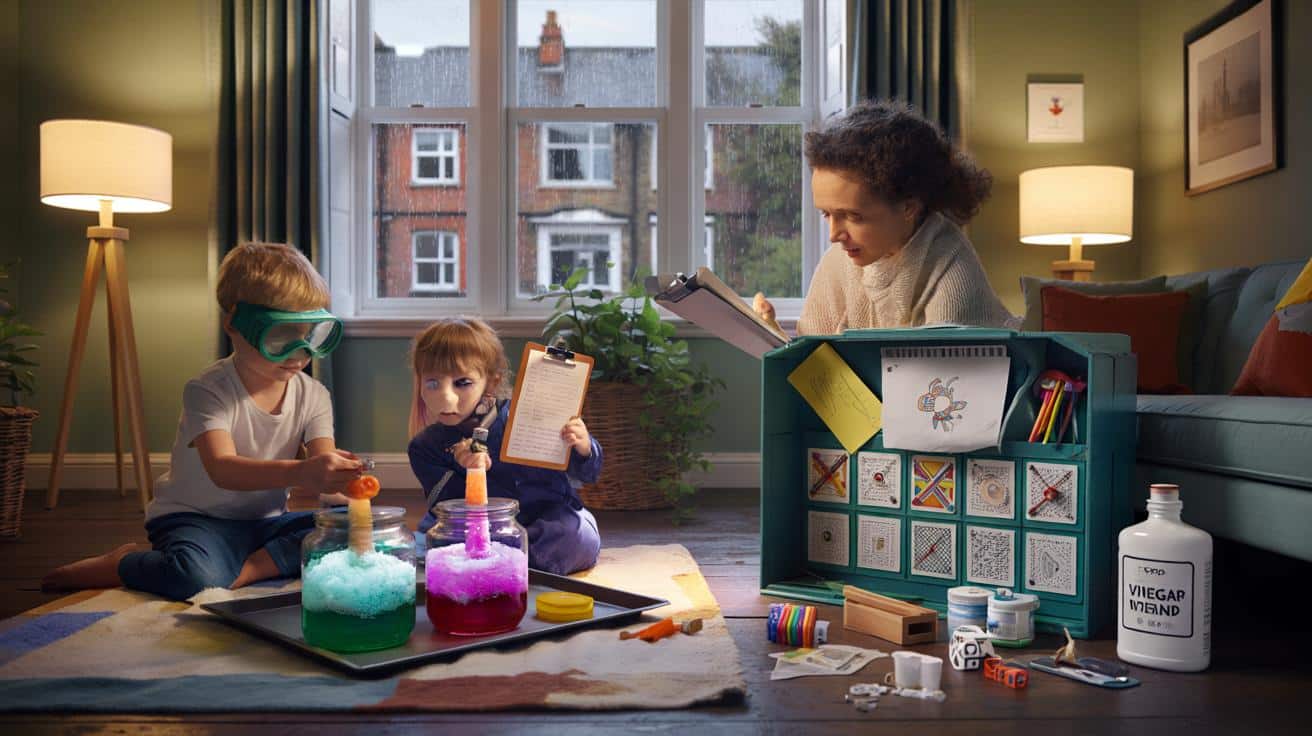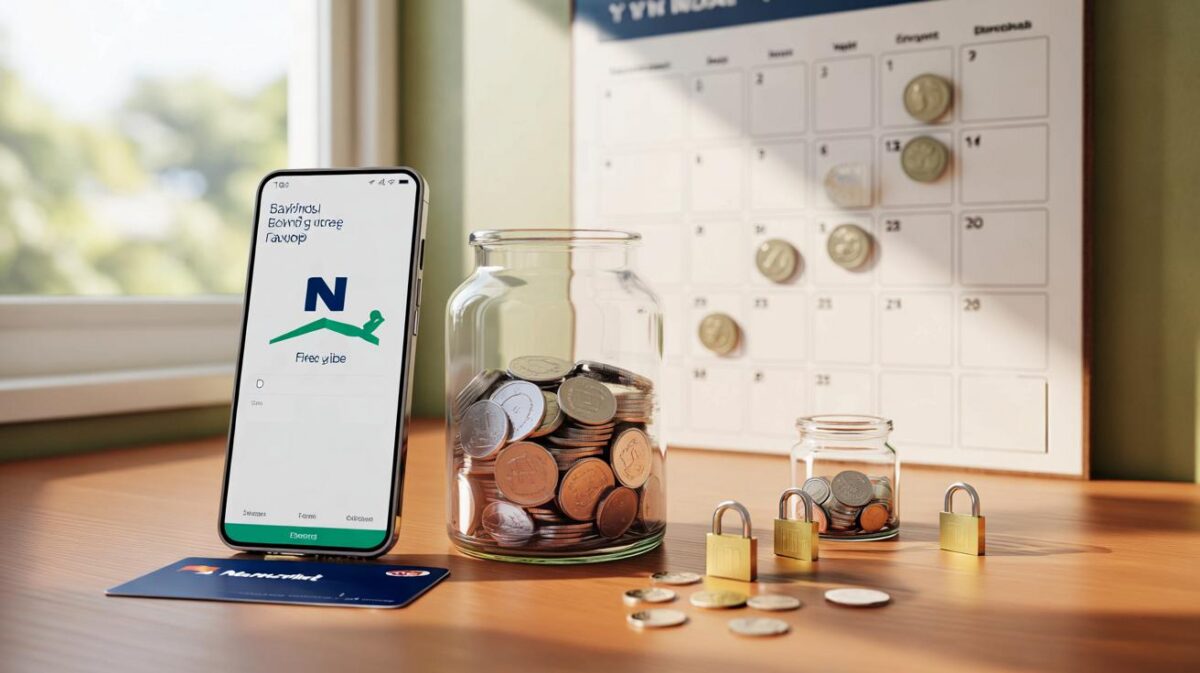Indoors, families juggle boredom, biscuits and screens while the clock ticks louder than rain.
Today, parents are flipping that script with small, low‑cost setups that spark curiosity and keep tempers cool while skies sulk. Think roles, not rules. Think five minutes to start, not fifty. Across kitchens and living rooms, the grey outside is becoming a cue for bright ideas inside.
A wet nation finds a new indoor rhythm
Many UK areas clock well over 130 rainy days a year, which means long stretches at home. The winning move is simple: name the play. When a day gets a job — “museum curator”, “news desk”, “space engineer”, “café taster” — children lean in. Shoulders rise. Eyes search. Hands get busy. The room changes character, and the noise shifts from whinging to questions.
Name the play, not the weather: give the day a job and watch questions outrun the rain.
Roles do the heavy lifting. They add story and purpose without expensive kit. Spilled water becomes “rain on Mars”, not a mistake. A cardboard box becomes “gallery storage”, not rubbish. That reframing keeps the dopamine of discovery humming while stress stays low. Parents report fewer arguments, quicker starts, and cleaner finishes because the task holds the focus.
From cabin fever to curiosity
Take a Leeds family who turned a drizzle‑drenched Sunday into “Kitchen Lab Live”. Jam jars stood in for beakers. Bicarbonate of soda met vinegar. Food colouring added theatre. A cereal‑box clipboard hosted “findings”, logged in felt‑tip. They ran a tidy‑up race to close the session: tools back to the “lab drawer” before the kettle boiled. Two young scientists, one calm afternoon, and no tears over towels.
Five‑minute setups that work in small flats
The Sticky‑Note Scavenger Hunt is a workhorse. Write ten clues and post them around one room, not the whole home. Aim at phonics, number, shape, or memory. Try “Find an object with an ‘sh’ sound”, “Count three blue circles”, or “Bring the book with a map on page two”. End with a “show‑and‑tell at the sofa” and offer two sentences of specific praise.
Keep the rules light. The one‑room rule protects your sanity. Younger children benefit from pictorial hints; older ones relish a riddle or a timer. Accept a little mess mid‑flow, then call a “two‑song tidy” to reset. Perfection can wait; momentum matters.
Small tools, fast starts: one room, ten notes, two songs to tidy — and the day feels different.
The rainy‑day caddy parents swear by
A caddy under the stairs turns drizzle into a prompt. Two clean jars, masking tape, crayons, a dice, pegs, a deck of cards, string, sticky notes, bicarbonate of soda, vinegar, a glue stick, an old magazine — that’s a newsroom, a lab, a puppet theatre and a dozen maths games within arm’s reach. One Bristol mum told me she stopped dreading wet Saturdays the week the box appeared: the children choose the day’s “job”, the atmosphere softens, and phones stay in pockets.
- Keep it small: a shoebox beats a suitcase.
- Choose tools over single‑use kits.
- Refresh one item a month for under £2.
- Tape a short idea list inside the lid.
The 20–20–20 method for focus without tears
Rituals keep rainy days on track. Light a lamp. Drop a blanket as “base camp”. Write the day’s role on a scrap of card. Then run a 20–20–20 cycle: twenty minutes to set up and play, twenty minutes to make or test, twenty minutes to share and show. Snap three photos — a grin, a drawing, the “exhibit” — to build a quiet archive for the next grey morning.
Rhythm beats willpower: 20–20–20 gives flow without fatigue or chaos.
| Move | What you need | Time | Learning gain | Clean‑up |
|---|---|---|---|---|
| Name the play | Role card: scientist, reporter, designer | 2 minutes | Focus, language, turn‑taking | None |
| Keep a caddy | Shoebox with simple tools | Grab‑and‑go | Problem‑solving, fine motor | Back in the box |
| Use 20–20–20 | Timer, blanket, phone camera | 60 minutes | Stamina, planning, reflection | Two‑song tidy |
Specific setups that punch above their weight
Sticky‑note newsroom
Children act as reporters. They “interview” a plant, a pet, or a parent. Prompts on notes steer the questions: What changed today? What colour is new? What surprised you? They dictate or write a headline, then present it at “press time”. This builds vocabulary and confidence while the rain drums on.
Kitchen science corner
Stick to safe reactions: vinegar plus bicarbonate for bubbles, oil and water for separation, ice and salt for melting rates. Use jam jars, spoons and a tray. Ask them to predict, test, and record. End with a “lab debrief” in two sentences. Children love the drama, and you quietly introduce fair tests and evidence.
Post for teddies
Make stamps from potato prints, fold envelopes from scrap paper, and sort “mail” by colour or number. One child becomes “postmaster”, another the “courier”. Routes sit inside the hallway, marked with masking‑tape arrows. This channels energy into purposeful movement and early maths.
What it costs, what it teaches
You can assemble a starter caddy for under £10 using household bits and a pound‑shop sweep. Most activities reuse items, so the monthly top‑up stays small. The pay‑off reaches across subjects: a scavenger hunt supports phonics and counting; a newsroom boosts speaking and listening; a science corner introduces prediction, testing and note‑taking; a café taste test builds descriptive language and comparison.
Skills travel. Roles nurture empathy and negotiation. Timed blocks train planning. “Show‑and‑tell” sharpens memory and pride in work. When children help set up and pack away, they also learn responsibility — a quiet win for busy homes.
Safety and sanity checks
- Use food‑safe ingredients for chemistry, and keep liquids on a tray.
- Mind small parts around under‑threes; swap buttons for large pegs.
- Check allergies before flour play or smell games with spices.
- Supervise scissors and tape; favour blunt‑end craft scissors.
- Set boundaries with masking tape to keep play in one zone.
Extra ideas for high‑energy hours
Run a “weather station” on the windowsill: track rain intensity, cloud types and wind direction with a paper streamer. Chart results with crayons and simple symbols. Or stage “toast critic”: compare two spreads, rate texture and flavour, and write a tiny review. Give clipboards status so pencils feel powerful.
Short on space? Create zones, not rooms. The blanket is the lab bench. The hallway becomes a gallery. The sofa is the stage. Tape marks edges so tempers stay cool. Add a dice for movement breaks: roll a 3 for three frog jumps, a 5 for five star jumps, then back to base camp.
For parents who want a quick start today
- Write “Scientist” on a card, lay out two jars, vinegar and bicarbonate, and put a tea towel under the tray.
- Hide ten sticky notes with phonics or colour prompts in one room and set a five‑minute timer.
- Build a shoebox caddy in ten minutes from drawers and recycling; tape three idea prompts inside the lid.
- Schedule one 20–20–20 block after lunch and take three photos for your rainy‑day album.
Low cost, high return: roles, caddy, and timed blocks turn wet weather into calm, clever play.
Useful angles to widen the idea
Try a simple “budget test”: cap each activity at £1 of consumables and see how many sessions you can run from recycling. Or add a “curriculum twist”: tag each setup with one reading, one number and one social skill. Children enjoy ticking the trio off on a homemade chart. Families of mixed ages can assign status by role — the older child edits, the younger tests — so everyone contributes without clashes.
When energy spikes, add sound. A “kitchen band” with wooden spoons and pans can rehearse a 60‑second anthem before the news bulletin. When focus dips, pivot to “rain on Mars”: a shallow tray, a cup of water, a few toy figures, and a towel under everything. Stop on a laugh, not a slump, and the next rainy morning will start on the front foot.








